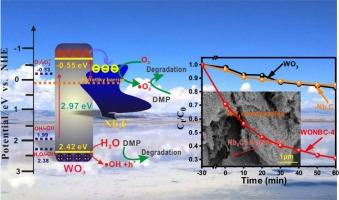在Nb2C MXene上锚定WO3纳米棒对浮选剂的有效降解
IF 4.6
3区 材料科学
Q2 MATERIALS SCIENCE, MULTIDISCIPLINARY
引用次数: 0
摘要
4-十二烷基啉(DMP)在盐湖工业钾肥生产中广泛使用,对盐湖生态环境和产品质量造成了负面影响。在这项工作中,我们设计了一系列不同含量比的WO3/Nb2C复合材料(WONBC-X)来解决危机。引入Nb2C后,DMP的光降解效率显著提高。在60 min光照条件下,WONBC-4对DMP的降解效率高达68.7%,是原始WO3的4倍。这主要是由于WO3与Nb2C界面之间形成了肖特基异质结,能有效抑制光激发载流子的复合。此外,复合材料中较大的比表面积和较强的光捕获能力也起着积极的作用。结果表明,Nb2C MXene在高效光催化体系中可以代替贵金属作为助催化剂。这项工作证明了1D/2D WO3/Nb2C肖特基异质结具有增强的光电化学性能。它还为保护水环境提供了一种环境友好型战略。本文章由计算机程序翻译,如有差异,请以英文原文为准。

Anchoring WO3 nanorods on Nb2C MXene for degrading flotation agent effectively
The 4-dodecylmorpholine (DMP) is widely used during the potassium fertilizers production in Salt Lake Industry, which has a negative impact on the ecological environment of Salt Lake and high-quality products. In this work, we designed a series of WO3/Nb2C composites (WONBC-X) with different content ratios to solve the crisis. The photodegradation efficiency of DMP was dramatically improved by the introduction of Nb2C. The DMP degradation efficiency of WONBC-4 was up to 68.7 %, which was 4 times higher than that of pristine WO3 under 60 min illumination. This is mainly due to the formation of Schottky heterojunction between WO3 and Nb2C interface, which can effectively inhibit the recombination of photoexcited carriers. Moreover, the larger specific surface area and the stronger light capturing ability in the composite also play an active role. The results show that Nb2C MXene can replace noble metals as a cocatalyst in the efficient photocatalytic system. This work demonstrates that the 1D/2D WO3/Nb2C Schottky heterojunction exhibits enhanced photoelectrochemical performance. It also provides an environmentally friendly strategy for protecting the water environment.
求助全文
通过发布文献求助,成功后即可免费获取论文全文。
去求助
来源期刊

Materials Science and Engineering: B
工程技术-材料科学:综合
CiteScore
5.60
自引率
2.80%
发文量
481
审稿时长
3.5 months
期刊介绍:
The journal provides an international medium for the publication of theoretical and experimental studies and reviews related to the electronic, electrochemical, ionic, magnetic, optical, and biosensing properties of solid state materials in bulk, thin film and particulate forms. Papers dealing with synthesis, processing, characterization, structure, physical properties and computational aspects of nano-crystalline, crystalline, amorphous and glassy forms of ceramics, semiconductors, layered insertion compounds, low-dimensional compounds and systems, fast-ion conductors, polymers and dielectrics are viewed as suitable for publication. Articles focused on nano-structured aspects of these advanced solid-state materials will also be considered suitable.
 求助内容:
求助内容: 应助结果提醒方式:
应助结果提醒方式:


